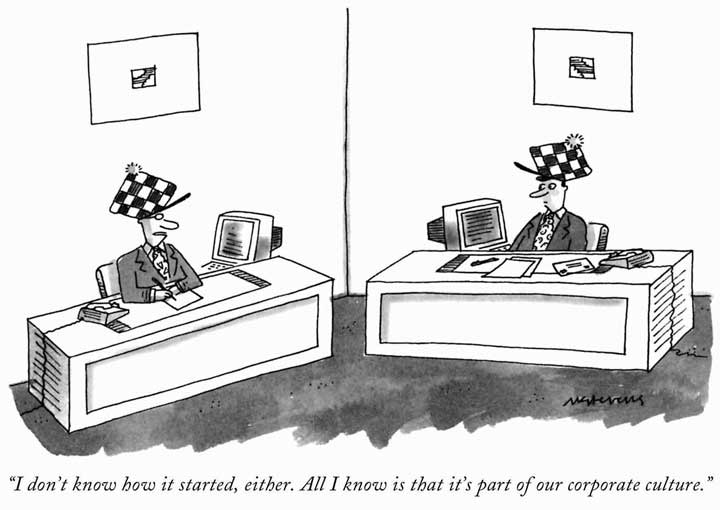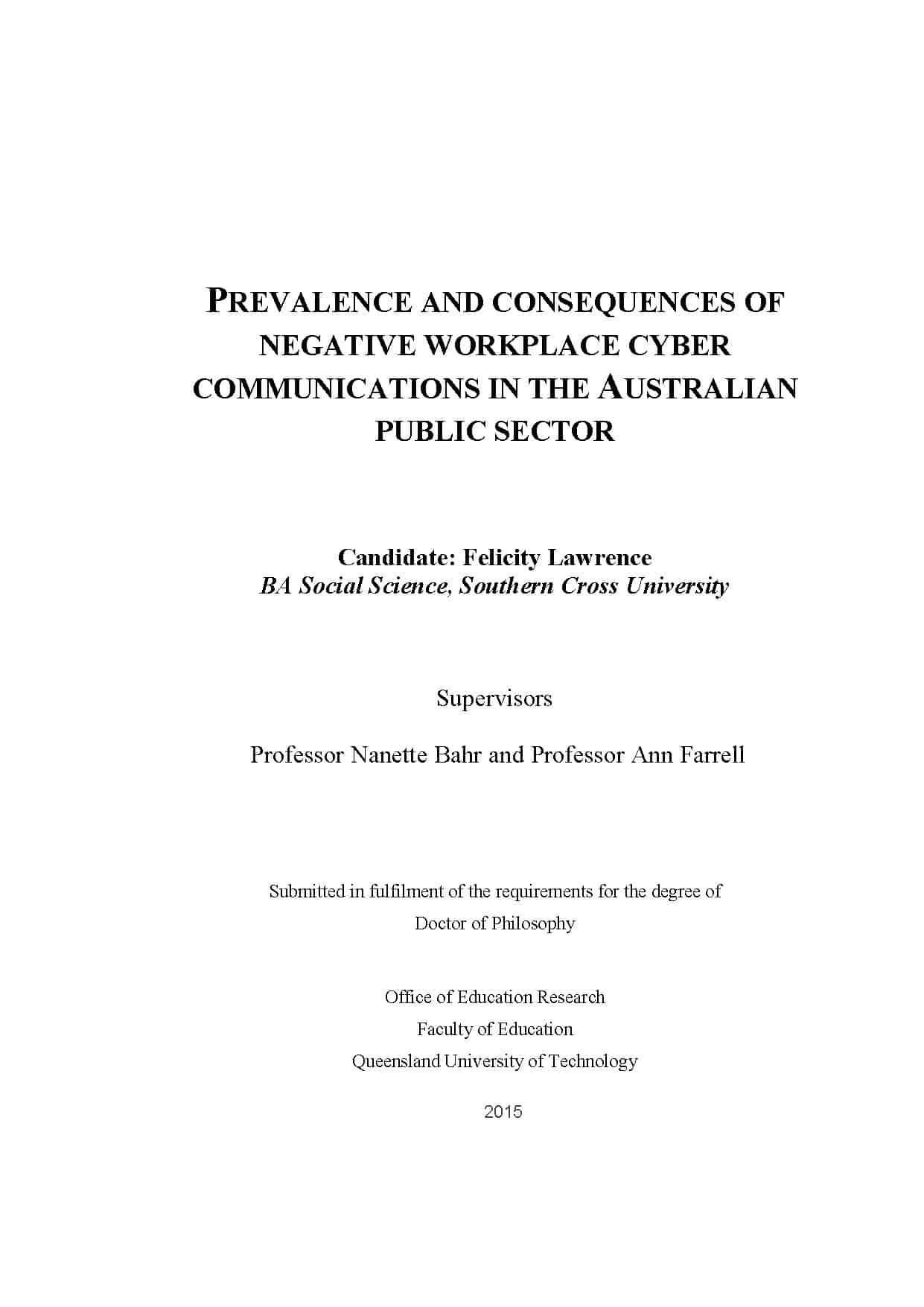
Image courtesy of http://images.flatworldknowledge.com/carpenter/carpenter-fig08_003.jpg
The research.
The first study comprised 24 confidential face-to-face interviews, the second extended to 127 responses to a text-based anonymous online
survey, while the third regarded a statistical anonymous online survey of 463 survey respondents. While this question was unexpectedly crucial in all three studies, it was further emphasised by the statistical results.
First of all, what is “organisational culture”?
According to Boucaut (2001, 2003) , culture is developed from the values, beliefs and
conduct requirements governing both workplace processes and employees’
behaviour and interactions, and is a significant element within the context of
the workplace. Other research (Tuckey, Dollard, Hosking, & Winefield, 2009) determined that the efficacy of cultural structures and procedures, rewards and
so on are critical in establishing healthy workplace cultures and behaviours.
In brief, what did my research find in response to the question posed above?
Qualitative data from my first two studies gathered text-based information that was analysed using Leximancer. One of the key findings was that employees perceived existing organisational (or agency) anti-bullying and harassment intervention and
prevention laws, policies and programs as extensive. However, many raised doubts as to the
capacity for existing frameworks to be effective within the new online context. This point was explained by one of the interviewees:
I don’t know whether our existing frameworks
[legislative and policy] will support us with cyberbullying or online stalking
or harassment behaviours or [are able to] take us, as a [organisation] into the
future. I really don’t know, that’s the short answer to your question. And
there’s another side of the coin, regarding whether there’s any legal provision
that could protect us [as] employees from clients that use [these] online
mechanisms.
Indeed, many employees admitted that, while some attempt had been
made to retrofit anti-workplace cyberbullying frameworks from the generally 1990’s workplace
laws, existing intervention and prevention measures were too slow and therefore ineffective when dealing with the immediacy of cyberbullying. This point was clarified by one interviewee, who said:
The old protection processes [policy
frameworks] were very different – there was personal discipline around account
management – only certain people signed their name to documents and they were
the [only] visible points of contact. Now the technology makes it easier for
people to exert pressure and professional defamation is a lot easier now, it’s
very easy for individuals to be held out for ridicule on websites…Websites are
also being used to publicly defame officials who are just doing their job.
[It’s] very hard to stop sophisticated campaigns especially for websites that
are internationally based. It’s hard to shut them down.
This observation was also described by employees who had observed, or
experienced, both overt and anonymous cyberbullying events (where the
perpetrator’s identity is disclosed or hidden), and/or occasions where online perpetrators
followed them from work to home, and job to job, state to state. Some other negative online behaviours that were viewed as bullying using technology (cyberbullying) included:
Destruction or removal of colleagues
work/electronic documents. Denigrating work colleagues in social media. Hacking
of colleagues online profiles. Publishing/distributing information protected by
privacy laws. Producing false emails to support allegations where no such
communications previously exist.
It is reasonable to suppose that internal
perpetrators (that is, other employees within the organisation rather than external clients and stakeholders) would be held to account for their actions, however one respondent wrote, “No repercussions or accountability for the behaviour of the individual
attacking the [staff member]....”
Employees dealing with cyberbullying from external clients and stakeholders reporting feeling even more vulnerable and powerless to defend themselves:
Clients posting negative or derogatory comments about staff on
line, providing personal details of staff members, misrepresenting what
actually happened in order to make staff appear wrong or incompetent,
publishing official correspondence from staff online and out of context, making
threats that this will happen to other staff members in the course of their
duty, in order to intimidate staff...
How the statistical data highlighted the impact of workplace cyberbullying on organisational culture.
While the qualitative evidence were deeply concerning, the findings from the statistical study* (the third and final project) highlighted employees' perceptions as to the potentially negative effect
cyberbullying has on organisational culture. This study found that over half (56.2%) of the nationally-based public sector participants reported associating workplace cyberbullying with ineffective organisational culture (workplace laws, policies and governance
practices).*Note: statistical data was analysed using a histogram and Spearman's rank non-parametric correlation coefficient, and found a statistically significant negative correlation (ρ = -.683 and - .581, p < .001) between participants perceptions of workplace cyberbullying and perceptions of organisational culture.
Background about the third study.
The third study was developed as a result of the findings from the first
two studies.
(reference: mixed method sequential exploratory research design, Bergman, 2008, 2010, 2011; Green, Caracelli, & Graham, 1989; Morgan, 2007; Morse, 2005; Plano Clark, 2010; Tashakkori & Teddlie, 1998).
(reference: mixed method sequential exploratory research design, Bergman, 2008, 2010, 2011; Green, Caracelli, & Graham, 1989; Morgan, 2007; Morse, 2005; Plano Clark, 2010; Tashakkori & Teddlie, 1998).
The sample size consisted of 463 survey responses and was deemed between good to very good
(Comrey & Lee, 1992), while the anonymous participants represented a diverse range of government employees, being as they worked across local, State, Territory and Commonwealth
nationally-based organisations and comprised all levels including Secretary/CEO, executive, middle-management and junior staff. As a consequence,
the findings from this third study are seen as statistically significant, and underpin the findings arising from the first two
(qualitative/text-base) studies.
What I believe this research means for Australian organisations.
Firstly, based on the empirical and consistent evidence arising
from these three studies, it seems clear that firstly, employees perceived existing anti-bullying and
harassment frameworks as extensive. However, employees also viewed these existing frameworks as generally vague and
inept in resolving, preventing or intervening in workplace cyberbullying events.
This finding of itself is deeply concerning, particularly given Zhangand Leidner’s (2014) observation, that while “workplace cyberbullying behaviors
are not likely to be treated as corporate crimes, they are behaviors that can
produce a hostile work climate and while not illegal, may violate
organizational norms and policies” (p. 2).
However, I believe equally concerning is the lack of awareness by organisational leaders regarding the effect of workplace cyberbullying on both their employees and their organisation's culture.
While this issue has been highlighted by my research, more
studies are needed to fully understand how aggressive and dysfunctional workplace
behaviours arise, how these behaviours are communicated (face-to-face or online), and out of the raft of existing prevention and intervention measures, which ones are actually working, and what needs to change.
Dr Lawrence has a BA SSc and a PhD in organisational social psychology and works with individuals and organisations as a consultant, speaker and trainer. She uses her social science expertise to enhance interactions between organisations and the people who lead and work in them by fostering new insights for diagnosing organisational problems, and build new capabilities and culture.





